Luca Soldaini
Amazon Alexa Search
olmOCR 2: Unit Test Rewards for Document OCR
Oct 22, 2025Abstract:We present olmOCR 2, the latest in our family of powerful OCR systems for converting digitized print documents, like PDFs, into clean, naturally ordered plain text. olmOCR 2 is powered by olmOCR-2-7B-1025, a specialized, 7B vision language model (VLM) trained using reinforcement learning with verifiable rewards (RLVR), where our rewards are a diverse set of binary unit tests. To scale unit test creation, we develop a pipeline for generating synthetic documents with diverse and challenging layouts, known ground-truth HTML source code, and extracted test cases. We show that RL training on these test cases results in state-of-the-art performance on olmOCR-Bench, our English-language OCR benchmark, with the largest improvements in math formula conversion, table parsing, and multi-column layouts compared to previous versions. We release our model, data and code under permissive open licenses.
Overview of the TREC 2024 NeuCLIR Track
Sep 17, 2025Abstract:The principal goal of the TREC Neural Cross-Language Information Retrieval (NeuCLIR) track is to study the effect of neural approaches on cross-language information access. The track has created test collections containing Chinese, Persian, and Russian news stories and Chinese academic abstracts. NeuCLIR includes four task types: Cross-Language Information Retrieval (CLIR) from news, Multilingual Information Retrieval (MLIR) from news, Report Generation from news, and CLIR from technical documents. A total of 274 runs were submitted by five participating teams (and as baselines by the track coordinators) for eight tasks across these four task types. Task descriptions and the available results are presented.
FlexOlmo: Open Language Models for Flexible Data Use
Jul 09, 2025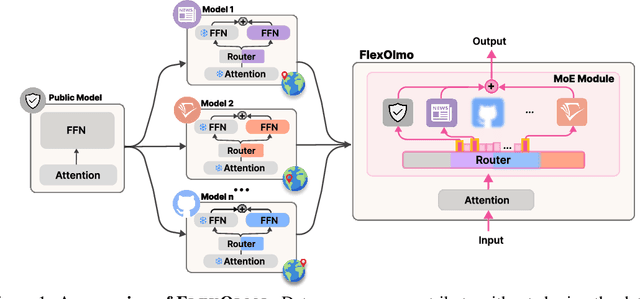
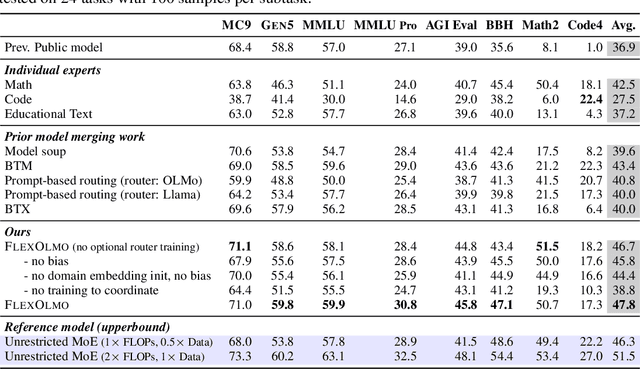
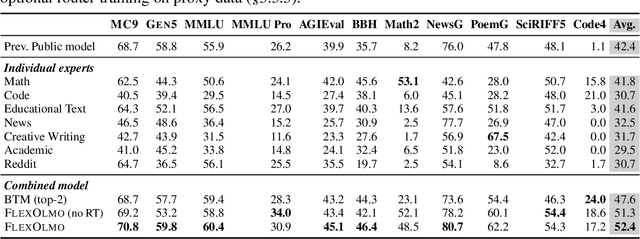
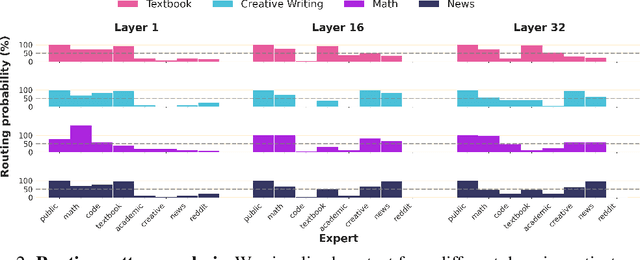
Abstract:We introduce FlexOlmo, a new class of language models (LMs) that supports (1) distributed training without data sharing, where different model parameters are independently trained on closed datasets, and (2) data-flexible inference, where these parameters along with their associated data can be flexibly included or excluded from model inferences with no further training. FlexOlmo employs a mixture-of-experts (MoE) architecture where each expert is trained independently on closed datasets and later integrated through a new domain-informed routing without any joint training. FlexOlmo is trained on FlexMix, a corpus we curate comprising publicly available datasets alongside seven domain-specific sets, representing realistic approximations of closed sets. We evaluate models with up to 37 billion parameters (20 billion active) on 31 diverse downstream tasks. We show that a general expert trained on public data can be effectively combined with independently trained experts from other data owners, leading to an average 41% relative improvement while allowing users to opt out of certain data based on data licensing or permission requirements. Our approach also outperforms prior model merging methods by 10.1% on average and surpasses the standard MoE trained without data restrictions using the same training FLOPs. Altogether, this research presents a solution for both data owners and researchers in regulated industries with sensitive or protected data. FlexOlmo enables benefiting from closed data while respecting data owners' preferences by keeping their data local and supporting fine-grained control of data access during inference.
The Common Pile v0.1: An 8TB Dataset of Public Domain and Openly Licensed Text
Jun 05, 2025Abstract:Large language models (LLMs) are typically trained on enormous quantities of unlicensed text, a practice that has led to scrutiny due to possible intellectual property infringement and ethical concerns. Training LLMs on openly licensed text presents a first step towards addressing these issues, but prior data collection efforts have yielded datasets too small or low-quality to produce performant LLMs. To address this gap, we collect, curate, and release the Common Pile v0.1, an eight terabyte collection of openly licensed text designed for LLM pretraining. The Common Pile comprises content from 30 sources that span diverse domains including research papers, code, books, encyclopedias, educational materials, audio transcripts, and more. Crucially, we validate our efforts by training two 7 billion parameter LLMs on text from the Common Pile: Comma v0.1-1T and Comma v0.1-2T, trained on 1 and 2 trillion tokens respectively. Both models attain competitive performance to LLMs trained on unlicensed text with similar computational budgets, such as Llama 1 and 2 7B. In addition to releasing the Common Pile v0.1 itself, we also release the code used in its creation as well as the training mixture and checkpoints for the Comma v0.1 models.
Teaching Models to Understand (but not Generate) High-risk Data
May 05, 2025Abstract:Language model developers typically filter out high-risk content -- such as toxic or copyrighted text -- from their pre-training data to prevent models from generating similar outputs. However, removing such data altogether limits models' ability to recognize and appropriately respond to harmful or sensitive content. In this paper, we introduce Selective Loss to Understand but Not Generate (SLUNG), a pre-training paradigm through which models learn to understand high-risk data without learning to generate it. Instead of uniformly applying the next-token prediction loss, SLUNG selectively avoids incentivizing the generation of high-risk tokens while ensuring they remain within the model's context window. As the model learns to predict low-risk tokens that follow high-risk ones, it is forced to understand the high-risk content. Through our experiments, we show that SLUNG consistently improves models' understanding of high-risk data (e.g., ability to recognize toxic content) without increasing its generation (e.g., toxicity of model responses). Overall, our SLUNG paradigm enables models to benefit from high-risk text that would otherwise be filtered out.
DataDecide: How to Predict Best Pretraining Data with Small Experiments
Apr 15, 2025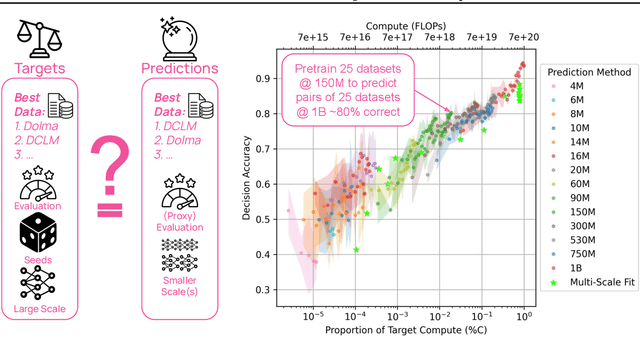
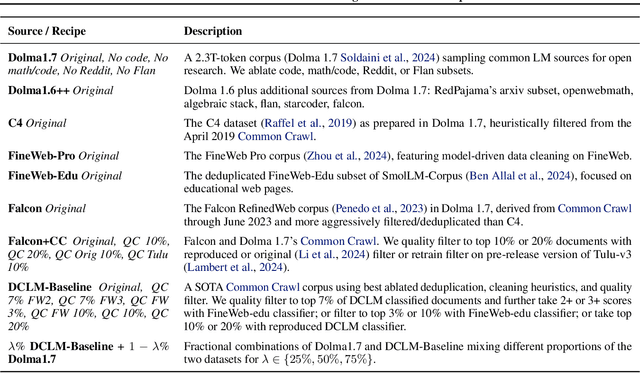
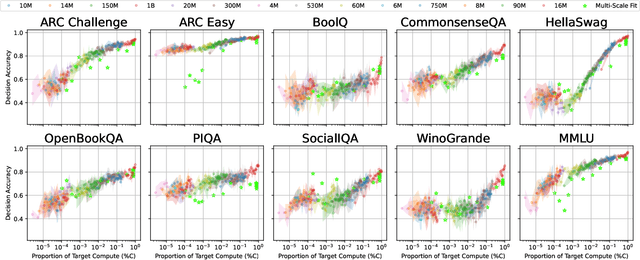
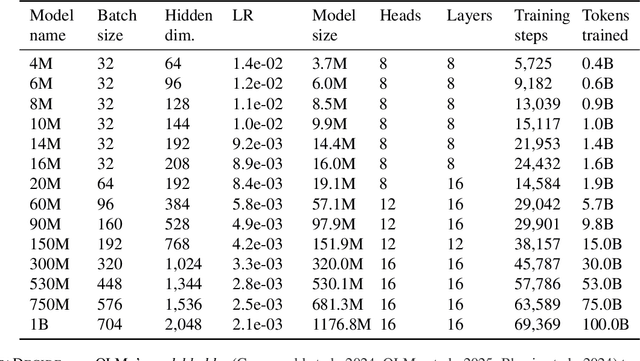
Abstract:Because large language models are expensive to pretrain on different datasets, using smaller-scale experiments to decide on data is crucial for reducing costs. Which benchmarks and methods of making decisions from observed performance at small scale most accurately predict the datasets that yield the best large models? To empower open exploration of this question, we release models, data, and evaluations in DataDecide -- the most extensive open suite of models over differences in data and scale. We conduct controlled pretraining experiments across 25 corpora with differing sources, deduplication, and filtering up to 100B tokens, model sizes up to 1B parameters, and 3 random seeds. We find that the ranking of models at a single, small size (e.g., 150M parameters) is a strong baseline for predicting best models at our larger target scale (1B) (~80% of com parisons correct). No scaling law methods among 8 baselines exceed the compute-decision frontier of single-scale predictions, but DataDecide can measure improvement in future scaling laws. We also identify that using continuous likelihood metrics as proxies in small experiments makes benchmarks including MMLU, ARC, HellaSwag, MBPP, and HumanEval >80% predictable at the target 1B scale with just 0.01% of the compute.
OLMoTrace: Tracing Language Model Outputs Back to Trillions of Training Tokens
Apr 09, 2025Abstract:We present OLMoTrace, the first system that traces the outputs of language models back to their full, multi-trillion-token training data in real time. OLMoTrace finds and shows verbatim matches between segments of language model output and documents in the training text corpora. Powered by an extended version of infini-gram (Liu et al., 2024), our system returns tracing results within a few seconds. OLMoTrace can help users understand the behavior of language models through the lens of their training data. We showcase how it can be used to explore fact checking, hallucination, and the creativity of language models. OLMoTrace is publicly available and fully open-source.
Automatic Detection of Research Values from Scientific Abstracts Across Computer Science Subfields
Feb 26, 2025Abstract:The field of Computer science (CS) has rapidly evolved over the past few decades, providing computational tools and methodologies to various fields and forming new interdisciplinary communities. This growth in CS has significantly impacted institutional practices and relevant research communities. Therefore, it is crucial to explore what specific research values, known as basic and fundamental beliefs that guide or motivate research attitudes or actions, CS-related research communities promote. Prior research has manually analyzed research values from a small sample of machine learning papers. No prior work has studied the automatic detection of research values in CS from large-scale scientific texts across different research subfields. This paper introduces a detailed annotation scheme featuring ten research values that guide CS-related research. Based on the scheme, we build value classifiers to scale up the analysis and present a systematic study over 226,600 paper abstracts from 32 CS-related subfields and 86 popular publishing venues over ten years.
olmOCR: Unlocking Trillions of Tokens in PDFs with Vision Language Models
Feb 25, 2025Abstract:PDF documents have the potential to provide trillions of novel, high-quality tokens for training language models. However, these documents come in a diversity of types with differing formats and visual layouts that pose a challenge when attempting to extract and faithfully represent the underlying content for language model use. We present olmOCR, an open-source Python toolkit for processing PDFs into clean, linearized plain text in natural reading order while preserving structured content like sections, tables, lists, equations, and more. Our toolkit runs a fine-tuned 7B vision language model (VLM) trained on a sample of 260,000 pages from over 100,000 crawled PDFs with diverse properties, including graphics, handwritten text and poor quality scans. olmOCR is optimized for large-scale batch processing, able to scale flexibly to different hardware setups and convert a million PDF pages for only $190 USD. We release all components of olmOCR including VLM weights, data and training code, as well as inference code built on serving frameworks including vLLM and SGLang.
mFollowIR: a Multilingual Benchmark for Instruction Following in Retrieval
Jan 31, 2025



Abstract:Retrieval systems generally focus on web-style queries that are short and underspecified. However, advances in language models have facilitated the nascent rise of retrieval models that can understand more complex queries with diverse intents. However, these efforts have focused exclusively on English; therefore, we do not yet understand how they work across languages. We introduce mFollowIR, a multilingual benchmark for measuring instruction-following ability in retrieval models. mFollowIR builds upon the TREC NeuCLIR narratives (or instructions) that span three diverse languages (Russian, Chinese, Persian) giving both query and instruction to the retrieval models. We make small changes to the narratives and isolate how well retrieval models can follow these nuanced changes. We present results for both multilingual (XX-XX) and cross-lingual (En-XX) performance. We see strong cross-lingual performance with English-based retrievers that trained using instructions, but find a notable drop in performance in the multilingual setting, indicating that more work is needed in developing data for instruction-based multilingual retrievers.
 Add to Chrome
Add to Chrome Add to Firefox
Add to Firefox Add to Edge
Add to Edge